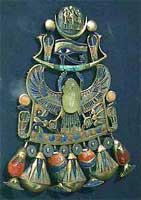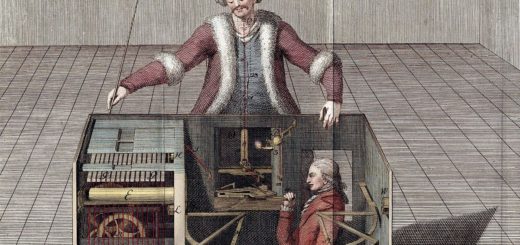King Tut’s glass beetle came from outer space
 (London Times) Scientists believe they have solved the mystery surrounding a piece of rare natural glass at the centre of an elaborate necklace found among the treasures of Tutankhamun, the boy pharaoh. They think a fragile meteorite broke up as it entered the atmosphere, producing a fireball with temperatures over 1,800C that turned the desert sand and rock into molten lava which became glass when it cooled.
(London Times) Scientists believe they have solved the mystery surrounding a piece of rare natural glass at the centre of an elaborate necklace found among the treasures of Tutankhamun, the boy pharaoh. They think a fragile meteorite broke up as it entered the atmosphere, producing a fireball with temperatures over 1,800C that turned the desert sand and rock into molten lava which became glass when it cooled.
Mystech: Before the wide-eyed disciples of Graham Hancock whip them into a frenzy, let me emphasize that millions of tons of meteoric material enter earth’s atmosphere daily and this (possible) piece and others have yet to have been proven to be ancient-astronautical pyramid builders. ;-P
Experts have puzzled over the origin of the yellow-green glass — carved into the shape of a scarab beetle — since it was excavated in 1922 from the tomb of the teenage king, who died about 1323BC. It is generally agreed that it came from an area called the Great Sand Sea but there has been uncertainty over how it was formed because there is no crater to back up the idea of a meteorite strike.
Now it is thought that the meteorite responsible was not intact but made up of loose rubble.
“A fireball moving quicker than a hurricane force would have meant a blast of air so hot it could melt all the sand and sandstone on the ground,” said Mark Boslough, an expert on impact physics based at the Sandia National Laboratories in New Mexico.
He recreated the effect on his computer and found that an object about 390ft in diameter and travelling at 12.4 miles a second would indeed produce enough heat to melt sand and create glass without leaving a crater as it broke up in the atmosphere.
The theory forms the basis of a BBC2 television programme, King Tut’s Fireball, to be shown next month.
“It would have become a molten lake of bubbling liquid sand and as the sand cooled it would have formed glass which ended up in King Tutankhamun’s jewellery,” said Boslough.
The necklace holding the 1in oval glass piece is housed in the Egyptian Museum in Cairo. It was one of hundreds of items discovered by the British archeologist Howard Carter in a tomb in the Valley of the Kings in Luxor.
In his diary Carter described the brightly coloured gem as “greenish yellow chalcedony”. However, in 1999 Italian geologists tested the chemical composition of the scarab and concluded it was not chalcedony but natural desert glass, which is found only in the Great Sand Sea 500 miles southwest of Cairo.
Many meteorite craters can be seen only from space, so satellite photography experts examined the area. Farouk El-Baz, director of the centre for remote sensing at Boston University said: “If this glass is of meteoric origin then there should be a crater of that age. But we did not find a smoking gun for silica (glass) there.”
Chunks of glass were discovered in 1932 by Patrick Clayton, a British surveyor operating in the desert with the Egyptian Geological Survey. “He ran into this funny area with this glistening stuff all over the place,” said his son Peter this weekend.
Next year an exhibition will be held in London showing for the first time many of the pieces found by Carter.





















